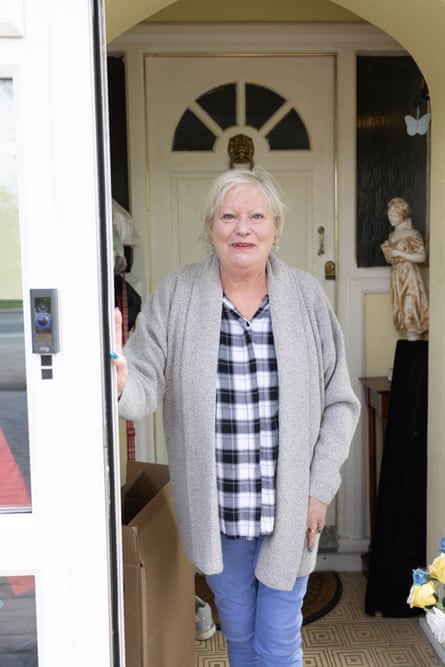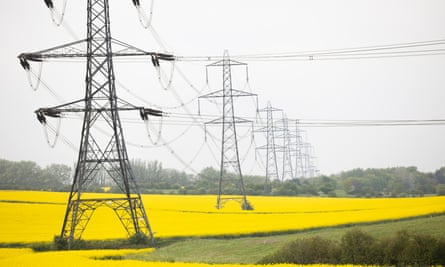‘They say it will ease traffic, but I can’t see it myself,” said Lyn Loines about Britain’s biggest road-building project, connecting north Kent with Essex via a huge, six-lane, 2.6-mile tunnel under the Thames.
Construction of the £9bn Lower Thames Crossing (LTC) will be on the doorstep of Loines’s house near Gravesend, blocking a view of green belt land that takes in lines of trees and rolling fields of bright yellow rapeseed. When work was complete, more cars and lorries would quickly fill up the roads, leaving everyone worse off, Loines said.
Experts’ opinions on the impact of the project remain unknown, as the Cabinet Office has blocked local campaigners from seeing an internal report that contains the views of government-appointed specialists. A formal complaint was recently sent to the information commissioner, in a bid to extract the report from the ministry’s archive.
The battle for the LTC is emblematic of the challenges of fighting the climate crisis and reducing air pollution while improving Britain’s creaking infrastructure.
The government has made it clear the project should go ahead in public statements. It has already sunk £800m into testing the ground on both sides of the Thames and preparing the biggest planning application ever assembled for a single scheme.
A few miles to the east of the overburdened Dartford Crossing – a bridge that was opened by Queen Elizabeth II in 1991, and two tunnels beneath the river – the Lower Thames Crossing will in effect act as a relief road. It will divert lorries heading from Kent’s ports, which make up about 50% of the traffic, away from the A2 on the south side of the Thames to the A13 in the north and then up to the M25 to destinations in the Midlands and beyond.
In March, ministers delayed the start date by two years, pushing construction to 2026, but said they remained committed to a 2032 completion date, subject to a ruling by the Planning Inspectorate next spring.
In the meantime, contracts are being signed for the road-building, with Balfour Beatty on board for much of the construction north of the tunnel, to tie down costs and try to stay within budget.
According to the Kent Invicta Chamber of Commerce and its thousands of members across the county, the six-lane tunnel is vital to the local economy. “It is our No 1 piece of strategic transport for the whole region,” said Jo James, chief executive of the Kent business group. “It is not a nice-to-have. It is essential.”
She added: “We need a trading route that can go through Kent, round London and up to the Midlands. This connectivity is needed if firms are going to get their goods to market on time.” The Essex and East Sussex chambers agree.
Underpinning the argument for the tunnel is the bumper-to-bumper traffic on the Dartford Crossing and the endless delays that cause tailbacks, not just on the M25, but through Dartford itself, encouraging drivers to rat-run through local streets.
Residents of Kent have also had to get used to the M20 periodically being turned into a car park for Operation Brock, a scheme to deal with Brexit delays at Dover, but which leaves miles of lorries queueing on the motorway.
National Highways and its subsidiary overseeing the project said the Dartford route was built to take a maximum of 135,000 vehicles a day, but regularly handled 180,000, or 33% more than its capacity.

Matt Palmer, the executive director of the Lower Thames Crossing, said the Dartford bridge and tunnel was “one of the most unreliable routes in the country”, causing delays and frustration for businesses, commuters and local communities.
“The Lower Thames Crossing will almost double road capacity across the Thames east of London, easing congestion, increasing productivity and access to jobs by creating a reliable new connection between the region’s ports, manufacturing centres and employment hubs,” he said.
Many agree that something needs to happen, but the plan for a huge new tunnel as a cure-all has caused uproar from environmental campaigners, MPs, councils and local people. A decline in the measurable economic benefits following wide-ranging revisions to the costs in 2020 has also forced the National Audit Office to voice its doubts.
Christina Spackman, who lives down the road from Loines in the once-secluded village of Shorne, said: “I’m already finding life is very difficult with the levels of traffic we have at the moment.
“What I want to know is: why should we believe them when they say how much it will cost? Look at what’s happened to High Speed 2 [the new north-south railway]. And why can’t we switch the commercial traffic to rail? Another tunnel just means more traffic and more pollution.”
Spackman’s district council has said it cannot back the tunnel without knowing more about the environmental impact. Thurrock council in Essex has objected outright, arguing that the motorway junction and extra roads needed would steal an unacceptably high 14% of its green belt land.
Mike Amesbury MP, a Labour member of the all-party transport committee, agrees that the government has failed to promote rail freight, preferring to “capitulate to the road lobby and its backbench MPs”. “We should be doing our utmost to get freight off the roads, but that isn’t happening,” he said.
While councillors in Dartford have supported the scheme, and National Highways says surveys show almost 80% of local businesses offer support, not all think it will achieve its aims.
Robert Wisdom, an independent estate agent in the town, said the LTC would be a magnet for drivers who would put extra pressure on local roads. “This whole area is built on old chalk quarries and the roads are already under pressure. Only the other week a road collapsed and we are still coping with the consequences of the closure,” he said. “It’s true tailbacks from the [Dartford] bridge cause terrible congestion, but there are other ways to deal with that problem. I would say local people want the existing road network to be better maintained than to have new ones.”

Laura Blake heads the campaign to halt the LTC. She said an admission by National Highways that it would only reduce traffic on the Dartford Crossing by 20%, leaving the latter over capacity from day one, made it the wrong solution.
She has crowdsourced enough funds to employ the law firm Leigh Day to pursue a freedom of information request seeking the findings of a review by the Infrastructure and Projects Authority (IPA), an agency of the Cabinet Office and Treasury.
Worried that the government will press ahead despite the impact on communities, the huge amount of carbon released during construction and the failure to end congestion at Dartford, Blake has appealed to the information commissioner to overturn ministers’ objections.
She said that while the Cabinet Office and Department for Transport supported the scheme, there could be reservations in the report: “Evidence shows the scheme fails to meet its objectives, wouldn’t solve the problems at the Dartford Crossing, and is not fit for purpose. It would be hugely destructive and harmful, and when finished, a complete waste of money.”
The Cabinet Office said the report “contains commercially sensitive information which could harm commercial negotiations”.
A calculation of the economic benefit to the area have fallen since the project was first mooted more than a decade ago. The adjusted benefit-cost ratio (BCR) – a calculation that judges a number above 1 to be economically beneficial – has dropped from 3.1 to 1.22. That reading keeps the project viable, but any cost overruns now could change the picture.

Blake points out that the analysis was based on costs in 2020, since when they have risen sharply because of an extension of the tunnel to meet environmental concerns and the escalating cost of materials and labour amid booming inflation.
Campaigners ask why more commercial traffic on the Dartford Crossing cannot be transported by rail, and why more container traffic cannot be sent to ports north of the Thames if its destination is north of the Thames.
These questions remain unanswered, officially at least, though experts say only a small proportion of containers could be redirected to rail without significant investment. Also, most UK ports are in private hands, preventing ministers from dictating a greener trade policy.
One transport planner said: “For 10 years the government has dithered, and now they are in a situation where it is the Lower Thames Crossing or bust. They don’t have an alternative.”
Greg Marsden, a professor at the Institute for Transport Studies at the University of Leeds, said he was “not ideologically for or against any particular size of roads programme” but that there was currently no credible pathway for the transport sector to comply with statutory carbon limits set for 2033-37. “On this basis, there is no justification for a major programme of new roads or road widening.”
If the project is rejected by the Planning Inspectorate, north Kent will be in danger of becoming a graveyard for major infrastructure projects.
Between Dartford and Gravesend stands Ebbsfleet, which former chancellor George Osborne said in 2014 he would promote as the first garden city in England for 100 years. It remains a small enclave with little scope to grow after Natural England declared much of the surrounding land a site of special scientific interest, effectively ruling out much of the housebuilding planned for the area.
Plans for a Disneyland-style theme park near Dartford have similarly struggled to get off the ground, after councillors balked at the dramatic increase in traffic it would entail.
Loines and Spackman will be happy if all these projects hit the buffers, maintaining what is left of their rural idyll.
“I was warned many years ago that this area would be swallowed up by London sprawl,” said Spackman. “And now it’s happening.”
Join the exciting world of cryptocurrency trading with ByBit! As a new trader, you can benefit from a $10 bonus and up to $1,000 in rewards when you register using our referral link. With ByBit’s user-friendly platform and advanced trading tools, you can take advantage of cryptocurrency volatility and potentially make significant profits. Don’t miss this opportunity – sign up now and start trading!







Recent Comments